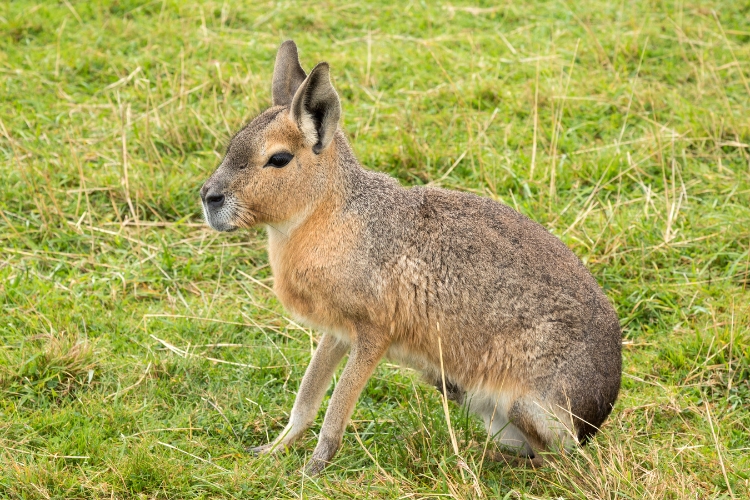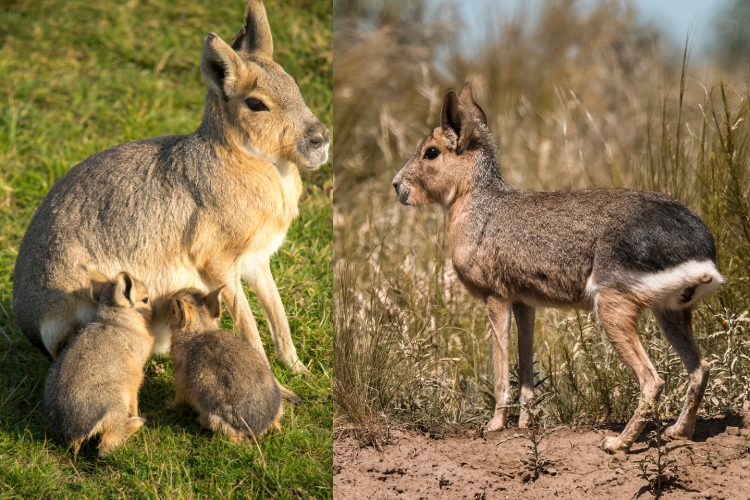The mara, also known as the Patagonian mara or Patagonian cavy, is a fascinating mammal native to the grasslands of Argentina. With their unique appearance and intriguing behaviors, these animals have captured the attention of wildlife enthusiasts and researchers alike.
In this article, we’ll explore 11 interesting facts about the Patagonian Mara, shedding light on their biology, habitat, social structure, and conservation status.
1. Mara Are Closely Related to Guinea Pigs
- Mara belong to the family Caviidae, which includes guinea pigs, capybaras, and rock cavies.
- Despite their resemblance to rabbits or small deer, mara are more closely related to these South American rodents.
- This evolutionary relationship highlights the diverse adaptations within the Caviidae family.
2. They Have a Unique Appearance
- Mara have long, slender legs adapted for running and leaping, similar to small deer or antelope.
- Their bodies are compact, with a short tail and small, rounded ears.
- Mara have a grayish-brown coat with a white patch on their rumps, which may serve as a visual signal to other mara.
3. Mara Are Social Animals
- Mara live in social groups called troops, typically consisting of one dominant male, several females, and their offspring.
- These troops can vary in size from a few individuals to up to 30 members.
- Within the troop, mara establish hierarchies and engage in social behaviors such as grooming and play.
4. They Are Diurnal and Crepuscular
- Unlike many rodents, mara are active during the day (diurnal) and at dawn and dusk (crepuscular).
- This activity pattern allows them to forage when temperatures are more favorable and predators are less active.
- During the hottest parts of the day, mara may seek shade and rest in shallow depressions called dust baths.
5. Mara Are Herbivores
- Mara are strictly herbivorous, feeding on a variety of grasses, herbs, and shrubs in their grassland habitat.
- Their diet is high in fiber and low in nutrients, requiring them to feed frequently throughout the day.
- Mara have a complex digestive system, including a large cecum, which allows them to extract maximum nutrients from their plant-based diet.
6. They Have a Unique Reproductive System
- Mara have a unusual reproductive system among mammals, known as “polyovulation.”
- Females typically give birth to litters of 2-3 precocial young, which are born fully furred and with their eyes open.
- Newborn mara can run and forage within hours of birth, reducing their vulnerability to predators.
7. Mara Are Excellent Runners
- With their long, slender legs, mara are built for speed and agility.
- They can reach speeds of up to 35 miles per hour (56 kilometers per hour) and make quick, zigzagging turns to evade predators.
- Mara also have strong hind limbs that allow them to make impressive leaps, covering distances of up to 6.5 feet (2 meters) in a single bound.
8. They Have Few Natural Predators
- Adult mara have few natural predators due to their size and speed.
- However, young mara may fall prey to predators such as pumas, foxes, and birds of prey.
- Mara rely on their keen senses, speed, and social groups to detect and avoid potential threats.
9. Mara Communicate Through Various Means
- Mara use a variety of vocalizations, body postures, and scent marking to communicate with one another.
- They produce a range of sounds, including whistles, purrs, and alarm calls, to convey different messages within the troop.
- Mara also use scent glands located on their cheeks and rumps to mark their territory and maintain social bonds.
10. They Are Ecosystem Engineers
- Mara play a crucial role in maintaining the health and diversity of their grassland habitats.
- Through their foraging activities, mara help to control the growth of vegetation, preventing the encroachment of woody plants.
- Their dust baths also create microhabitats that can be used by other small animals, such as insects and reptiles.
11. Mara Face Conservation Challenges
- While mara are not currently considered endangered, they face several threats to their populations.
- Habitat loss and fragmentation due to agricultural expansion and human development have reduced the available grassland habitat for mara.
- Hunting for their meat and fur also poses a threat in some areas, although this is less common than in the past.
Mara Population and Conservation Status
| Fact | Details |
|---|---|
| Scientific Name | Dolichotis patagonum |
| Conservation Status | Near Threatened (IUCN Red List) |
| Population Trend | Decreasing |
| Habitat | Grasslands, steppes, and shrublands of Argentina |
| Threats | Habitat loss, fragmentation, hunting |
Conclusion
The mara is a remarkable mammal with a fascinating biology and ecology. From their unique appearance and social structure to their role as ecosystem engineers, these animals have much to teach us about the wonders of the natural world.
By understanding and appreciating the mara, we can better protect and conserve these incredible creatures and the grassland habitats they call home. As we continue to study and learn from the mara, let us strive to ensure that future generations will have the opportunity to marvel at these majestic animals in the wild.
FAQs:
- What is a Patagonian mara?
The Patagonian mara, also known as the cavy hare or mara, is a large rodent native to the grasslands of Argentina and southern Chile. It’s often mistaken for a hare or rabbit, but it’s actually more closely related to guinea pigs and capybaras.
- How big is a Patagonian mara?
The Patagonian mara is the fourth-largest rodent in the world, after the capybara, beaver, and agouti. They can grow up to 3 feet long and weigh up to 80 pounds.
- What do Patagonian maras eat?
Patagonian maras are herbivores and primarily eat grasses, herbs, and seeds. They use their sharp front teeth to graze and their strong hind legs to hop long distances when searching for food.
- Are Patagonian maras social animals?
Patagonian maras can be social animals and live in small groups of up to 12 individuals. These groups are typically made up of a breeding pair and their offspring from the previous few years.
- Are Patagonian maras endangered?
The Patagonian mara is not currently classified as endangered by the IUCN. However, their populations are threatened by habitat loss due to agriculture and livestock grazing.



